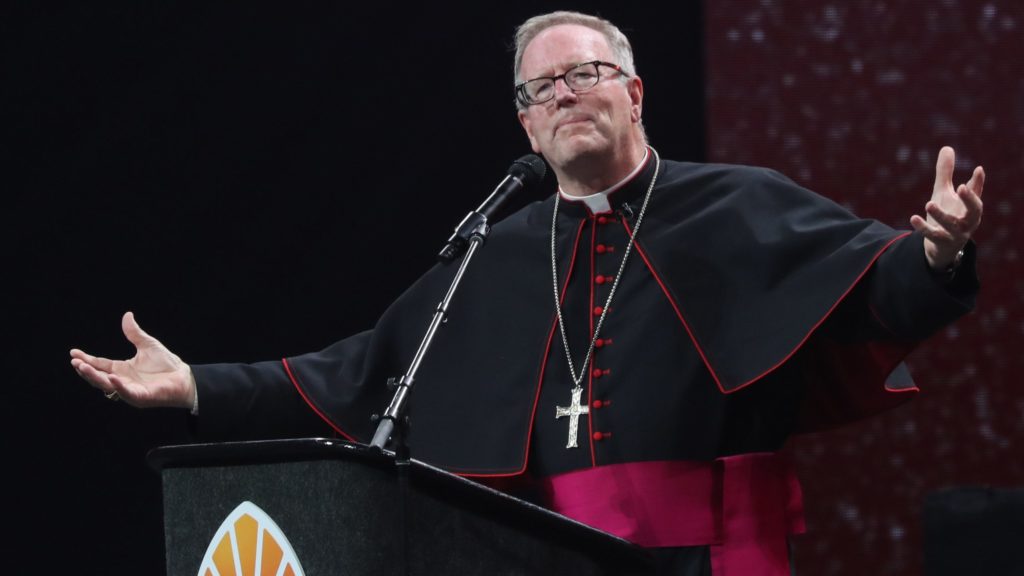I have just returned from the magnificent National Eucharistic Congress in Indianapolis. I can honestly say that those several days constituted one of the greatest moments in my thirty-eight years as a priest. To see more than 50,000 faithful laity, thousands of priests, over 150 bishops, armies of habited religious both men and women, and hundreds of seminarians all gathered together to celebrate and commune with their Eucharistic Lord was splendid beyond words. I have spoken to some large crowds in my time—including twenty-six thousand in an arena in Krakow for World Youth Day and ten thousand in the Anaheim Convention Center for the LA Congress—but I have never faced 50,000 before. The experience was overwhelming. But the most moving part of the Indy celebration for me was the public procession on Saturday afternoon. As thousands upon thousands of bishops, priests, nuns, and seminarians marched through the streets of downtown Indianapolis, we were cheered by thousands upon thousands of lay faithful—and all of us were simply part of a great symbolic pilgrimage in honor of Jesus in the Blessed Sacrament. Will I ever forget the silence that fell upon the massive park in central Indianapolis when, after the festive procession, we all knelt to venerate the Lord and receive his benediction?
What made this event so successful? We could speak, of course, of the dedication and intelligence of the myriad people entrusted with logistics and planning. We could speak of the cleverness of the advertising and the efficacy of the Catholic communication network. But none of that would be sufficient. What made the Congress successful is that it was predicated upon the supernatural. It exuded the spirit of the supernatural. It ordered us toward the infinitely fascinating world that we cannot see, the world of the angels and saints and the Creator God. At the heart of the entire event was the unnerving mystery of the Eucharist, that Jesus—Body, Blood, Soul, and Divinity—is really present under the forms of bread and wine. No merely earthly or natural category could possibly account for this. It makes sense only from a supernatural perspective.
And this moves me to make a provocative claim: liberal Catholicism could never have pulled off what happened in Indianapolis. I understand that the term is slippery; so, I will define it precisely. By “liberalism” in religion, I mean the tendency to reduce the supernatural to the natural. Liberal Catholicism was regnant when I was going through school, and it took the form of expressing the doctrines of Christianity in terms of anthropology, psychology, and especially politics. If, during my grade school and high school years, you had asked me what religion was all about, I probably would have said “social justice, especially racial justice.” A little later in life, if you had asked me the same question, I might have said, “becoming a well-adjusted and generous human being.” Obviously, there isn’t one little thing wrong with social justice, being well-adjusted, or generosity. The problem is reducing religion to these concerns and its purpose to these results. When we do so, the faith becomes, at best, a faint echo of what can be heard in the secular culture, and when that happens, people very quickly lose interest. And this is why liberal Catholicism has never generated the kind of energy and enthusiasm that I saw in Indianapolis.
If I may put this in a broad, metaphysical context, the problem with liberalism is that the natural cannot contain or adequately bear the supernatural. When it pretends to do so, we end up with, at best, a simulacrum of the supernatural. However, the supernatural can indeed contain and perfect the natural, according to the principle whereby a higher form of existence can elevate a lower. Consider the way in which nutrients are taken in by a plant and a plant assimilated by an animal. This principle of assimilation prevents Christianity from devolving into some form of crude dualism. The supernatural God created the natural world, which therefore reflects some of his goodness and beauty. Moreover, that same God redeemed the world and endeavors to draw it into union with himself. So, in a word, the supernatural cannot be naturalized, but the natural can be supernaturalized.
One of the distinctive marks of this Congress was the presence of so many religious and priests in habits and clerical garb. I heard one participant comment, “I had no idea there were so many orders in the Church!” Another mark was how attractive these people were, especially to the young. Smiling nuns in habits seemed to be especially magnetic. Years ago, when I was in the seminary, the wearing of distinctive religious dress was, in line with the liberal instincts of the time, frowned upon. Priests and nuns were supposed to look as natural as possible. It is, of course, no accident that vocations to orders that eschewed the habit plummeted. Once again, if there is nothing on offer that is distinctive or redolent of a mysteriously higher world, why bother?
I want to make a final observation that accords with the principle of assimilation I mentioned above. A critic might complain that what I’m advocating would lead to a dangerous “other-worldliness,” an indifference to the suffering of real people around us. One of my favorite photos from the Congress shows two young, habited nuns sitting on the sidewalk with a homeless person, laughing and sharing food with him. Understood properly, a focus on the supernatural intensifies one’s commitment to the elevation and amelioration of the natural—a principle firmly grasped by Ambrose of Milan, Francis of Assisi, Elizabeth of Hungary, Dorothy Day, and Mother Teresa of Kolkata.
Three enthusiastic cheers for all those who planned and participated in the Eucharistic Congress. And God bless them for allowing the spirit of the supernatural to breathe through the proceedings.

